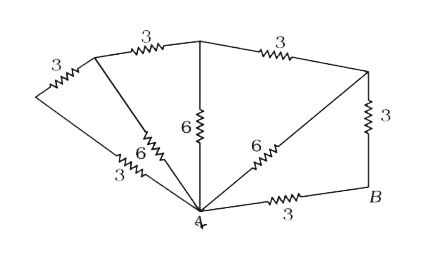State and explain Ohm.s law and hence defined one ohm.
Video Solution
Text Solution
At constant temperature the current passing through a conductor is proportional to the potential difference between its ends.
If I is the strength of current flow through the conductor when the p.d. across its ends is V volt. Then I∝V
V=IR
R is a constant called electrical resistance. Its value depends on the nature of the material of conductor, dimensions and temperature of the conductor. Ohm.s law gives the relation between the current and voltage. It is not a universal law. It is not applicable for all substances. It is applicable only at constant temperature.
|
Topper's Solved these Questions
- CURRENT ELECTRICITYBOOK - AAKASH SERIESCHAPTER - CURRENT ELECTRICITYEXERCISE - EXERCISE (VERY ANSWER QUESTIONS) (Choose the correct alternative)
3 Videos
- CURRENT ELECTRICITYBOOK - AAKASH SERIESCHAPTER - CURRENT ELECTRICITYEXERCISE - PROBLEMS (LEVEL-1)
17 Videos
- CURRENT ELECTRICITYBOOK - AAKASH SERIESCHAPTER - CURRENT ELECTRICITYEXERCISE - EXERCISE (SHORT ANSWER QUESTIONS)
12 Videos
- COMMUNICATION SYSTEMS BOOK - AAKASH SERIESCHAPTER - COMMUNICATION SYSTEMS EXERCISE - PRACTICE EXERCISE (TV Antenna)
16 Videos
- CURRENT ELECTRICITYBOOK - AAKASH SERIESCHAPTER - CURRENT ELECTRICITYEXERCISE - EXERCISE - IA
2 Videos
Similar Questions
Knowledge Check
Ohm.s law in vector form is :
AV=I.RB→j=σ→EC→E=σ→jD→j=σ→E
State and explain the second law of thermodynamics.
View SolutionState and explain Boyle's law. Represent the law graphically.
View SolutionState Ohm' law and deduce it from the knowledge of drift velocity of free electrons in a conductor carrying current.
View SolutionState Ohm's law. How can it be verified experimentally ? Explain with the help of a circuit diagram. Express the result graphically.
View SolutionAll resistance in the diagram are in ohm
Find the effective resistance (in ohm) between the points A and B

View SolutionState and explain the pressure-temperature law.
View SolutionState the physical condition in which Ohm.s law is not valid for a conductor.
View Solution
